In this article:
Swelling caused by the accumulation of excess fluid inside body tissue is referred to as edema or water/fluid retention.
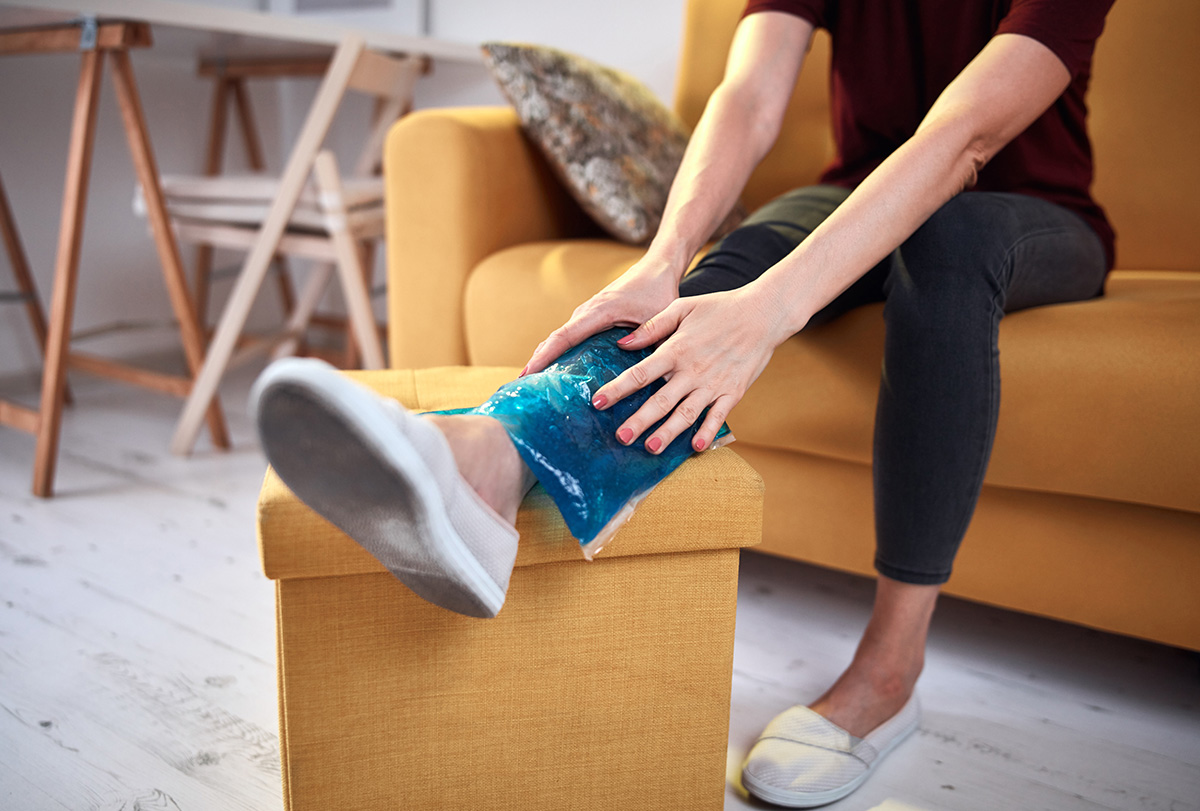
This condition can affect any part of the body but mostly occurs in the legs, feet, and ankles, which carry the load of your body throughout the day.
The constant strain can damage small blood vessels called capillaries in the lower extremities and can make them leak fluid, which is absorbed by the surrounding tissue. The fluid buildup makes the area swollen, painful, and sensitive to the touch. (1)
Home Remedies for Swollen Feet
Water retention in the ankles, feet, or legs can usually be resolved through simple home care. Here are some tips and remedies that can help relieve peripheral edema without the use of medication.
1. Follow the RICE protocol
Any injury to a body part triggers inflammation in the area, which manifests in the form of pain and swelling.
The underlying blood vessels may rupture due to the trauma and leak blood into the surrounding tissue, causing bruising. Plus, the body sends white blood cells and other inflammatory substances to the affected site as a natural immune response.
The pooling of blood, white blood cells, and other fluids around the injured tissue make the area swell up. (2)
The most commonly used first-line treatment for reducing swelling caused by injury, including foot injuries, is the RICE protocol. It involves the following steps:
Rest
If your foot or ankle gets injured, limit its movement for the first few days to avoid further damage.
Ice
Applying ice on the injured foot helps restrict blood flow in the area and numbs the underlying nerve endings to relieve the pain and swelling instantly. This effect only lasts only for a short period, so you need to ice the area multiple times, as and when needed.
Just wrap a few ice cubes in a clean washcloth or thin towel and place it on the injured area for no more than 20 minutes at a stretch. Wait for 40 minutes before reapplying.
Compression
Applying an elastic wrap around the injured foot will help limit the spilling of blood and fluid from the damaged capillaries in the adjoining tissue. This will reduce swelling or edema. (2)
Elevation
The (foot/ankle) should be raised slightly above the level of your heart to reduce swelling. (2) Elevation of the injured part lowers the pressure in local blood vessels.
Moreover, when your feet are above your heart level, the downward push of gravity will gradually drain out the excess water collected in the tissue (2) and will reduce and limit the edema
How to do:
- Prop your feet on a raised surface while you rest.
- You can also put a pillow under your feet while sleeping.
2. Massage with grapefruit essential oil
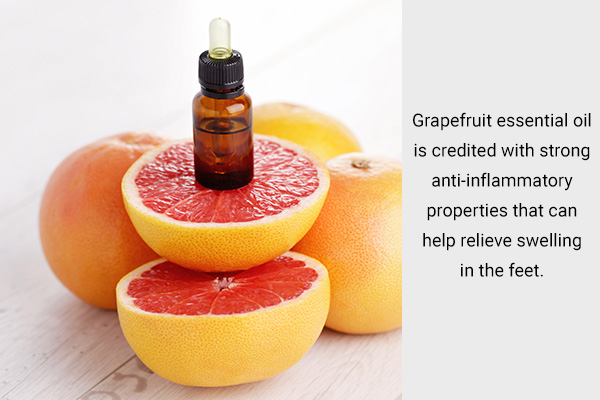
Grapefruit essential oil is credited with strong anti-inflammatory properties that can help relieve swelling in the feet. (3)
How to use:
- Mix a few drops of grapefruit essential oil in a carrier oil and massage this blend on your feet for a few minutes.
- Put a few drops of grapefruit essential oil in a tub of warm water and soak your feet in it.
- Add a few drops of grapefruit essential oil to your lukewarm bathwater.
3. Use dandelion
Dandelion is loaded with polyphenols, flavonoids, and potassium, (4) all of which exhibit anti-inflammatory effects that can relieve swelling in the feet.
This medicinal herb also works as a natural diuretic that increases urinary output and thus eliminates excess water from the body, including the lower extremities.
How to use:
- Make dandelion tea by adding the herb to boiling water and allowing it to steep for 5 minutes.
- Drink this tea while it is still warm.
- Have 1–2 cups per day till you find relief from foot edema.
4. Do an Epsom salt foot soak
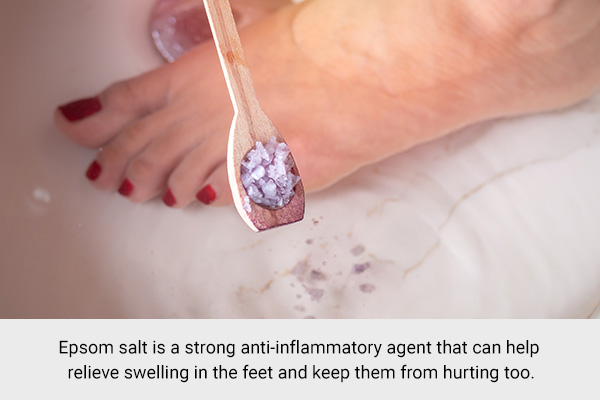
Epsom salt is a strong anti-inflammatory agent that can help relieve swelling in the feet and prevent them from hurting too. (5) It stimulates blood circulation under the skin, which promotes better lymphatic drainage and thus reduces fluid retention in the area.
How to use:
- Fill a large bowl or bucket with warm water, mix in ½ a cup of Epsom salt, and immerse your feet in it for 15 minutes. Do this regularly until the swelling goes away completely.
- Mix a full cup of Epsom salt in a bathtub filled with comfortably warm water, and soak your body in it for 10–15 minutes. You can also add a few drops of essential oils like lavender, rosemary, or mint for extra relaxation.
5. Wear compression socks
Compression socks are designed to exert pressure on the lower extremities to squeeze out the fluid collected in the underlying tissue so that it can get back into circulation via the blood. The extra fluid is either reabsorbed in the body or eliminated through urine. (6)
These socks fit snugly around the lower legs and feet; they are not too tight, which can exacerbate the swelling. You can purchase them online or over the counter from your local pharmacy.
However, people with moderate or severe edema should consult their doctor about getting a prescription compression stocking.
6. Reduce salt in the diet
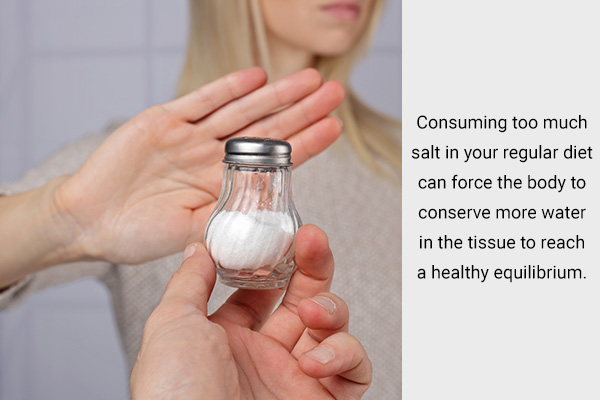
Your body has to maintain a balance between sodium and water levels for proper functioning.
Consuming too much salt in your regular diet can disturb this ratio and force the body to conserve more water in the tissue to reach a healthy equilibrium. But this kind of fluid retention will inadvertently cause bloating and swelling. (7)
Thus, people who are already suffering from edema in the feet are especially recommended to cut down their salt intake.
7. Get plenty of potassium
Potassium plays a critical role in maintaining proper electrolyte balance in the body.
It counteracts the effect of sodium to inhibit water retention in the tissue. Plus, it acts as a diuretic, increasing urine flow, which drains out the excess fluid from the body. Both these mechanisms help reduce swelling in the feet. (8)
Add more potassium-rich foods to your daily diet, such as figs, avocado, rhubarb, artichokes, kiwi, lettuce, papaya, parsley, banana, spinach, blackstrap molasses, scallions, celery, cabbage, dill, and arugula.
8. Ensure adequate magnesium levels
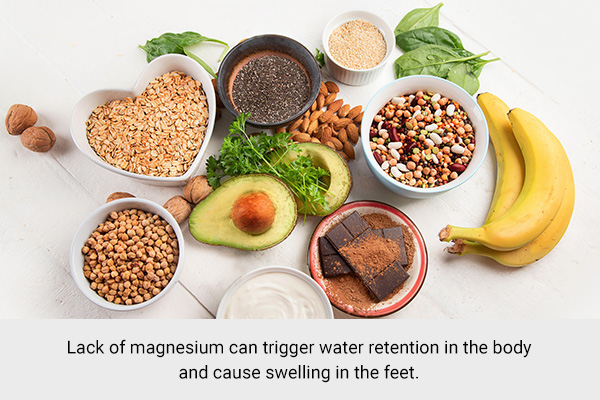
Lack of magnesium can trigger water retention in the body and cause swelling in the feet. (9) So, get your magnesium levels checked to make sure they are within the normal range.
If you do have a deficiency, consult your doctor about starting a magnesium supplement. Doctor-recommended dosage is 200–400 mg per day, unless you have a kidney or heart problem.
You can naturally increase your magnesium levels by consuming foods rich in this nutrient such as dark leafy greens, nuts, and dark chocolate.
9. Maintain proper water intake
Your body needs water to perform various life-sustaining functions, down to the cellular level.
Inadequate water intake on a regular basis can leave you dehydrated. As a result, your body will start storing water in the tissues to meet its physiological needs. The buildup of fluid in the tissues will inadvertently cause swelling.
So, it is essential to consume at least 7–8 glasses of water every day to prevent undue water retention in the body.
People who are already suffering from edema-induced swelling in the feet should consider drinking more water to bring down the inflammation.
10. Try a tonic water soak
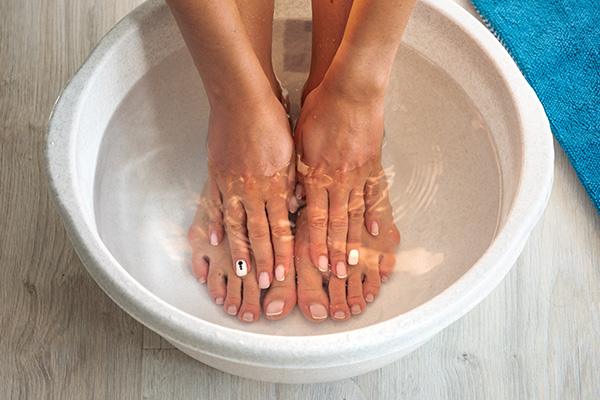
Soaking your swollen feet in a bucket full of cold or tepid tonic water for half an hour or more can provide quick relief.
11. Try a lymphatic drainage massage
Lymphatic drainage massage involves using your hands or an instrument to encourage the flow of lymphatic fluid in targeted areas. The topical stimulation opens up the underlying lymphatic vessels to release the excess fluid and thereby relieve the swelling.
There are various lymphatic drainage massage techniques you can use, such as the one-way pump, long stroking, and kneading.
Common Causes of Swollen Feet
Here are some factors that can trigger swelling in the ankles, feet, and legs:
- Standing or sitting in the same position for extended periods
- Excessive sodium intake
- Excess body weight
- Being pregnant
- Foot injury – such as a strain, sprain, or Achilles’ tendonitis
- Blood clot
- Insect bite or sting
- Infection (1)(10)
- Kidney, liver, or heart problems (10)
- Protein loss
- Deep vein thrombosis
- Hypothyroidism
- Side effect of certain medications such as antihypertensive drugs, birth control pills, hormone therapy, antidepressants, and steroids (10)
In ambulatory patients (who can walk but are not bedridden), edema occurs in the feet and lower legs. (11)
When to See a Doctor
Swollen feet require medical attention if you have the following signs, symptoms, and conditions:
- Fever
- Foot pain
- Foot pain that gets worse
- Swelling that spreads to other parts of the body
- Swelling that persists despite home treatment
- Sudden onset of foot swelling
- Shortness of breath
- History of a heart disorder or an abnormal cardiac examination
- Liver disorder
- Unilateral leg swelling with tenderness
- History of diabetes or hypertension
Final Word
Swelling in the feet is rarely a cause for concern, but it can be quite painful and discomforting while it lasts. You may not be able to move about as much as you want, which can hamper your daily routine.
Fortunately, plenty of simple home remedies can make this problem go away quickly. You may have to try different remedies to see which one suits you best. However, if the pain and swelling in your lower extremities do not subside even after adequate rest and care at home, reach out to a doctor.
Fluid retention in the feet can be the result of various underlying conditions that may require proper diagnosis and treatment.
- Was this article helpful?
- YES, THANKS!NOT REALLY


